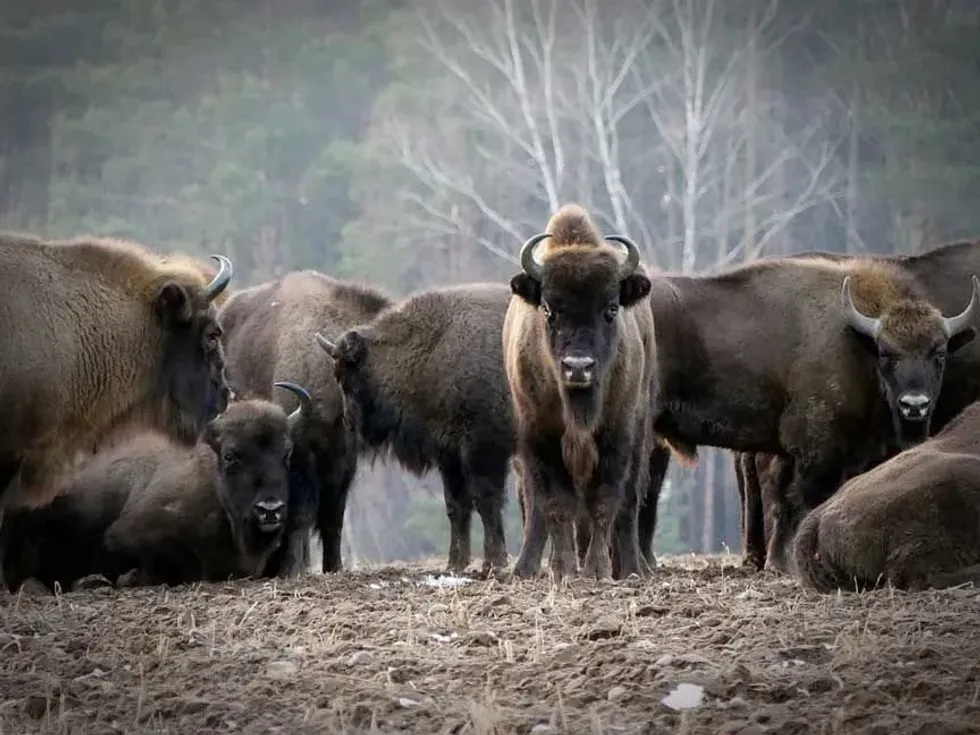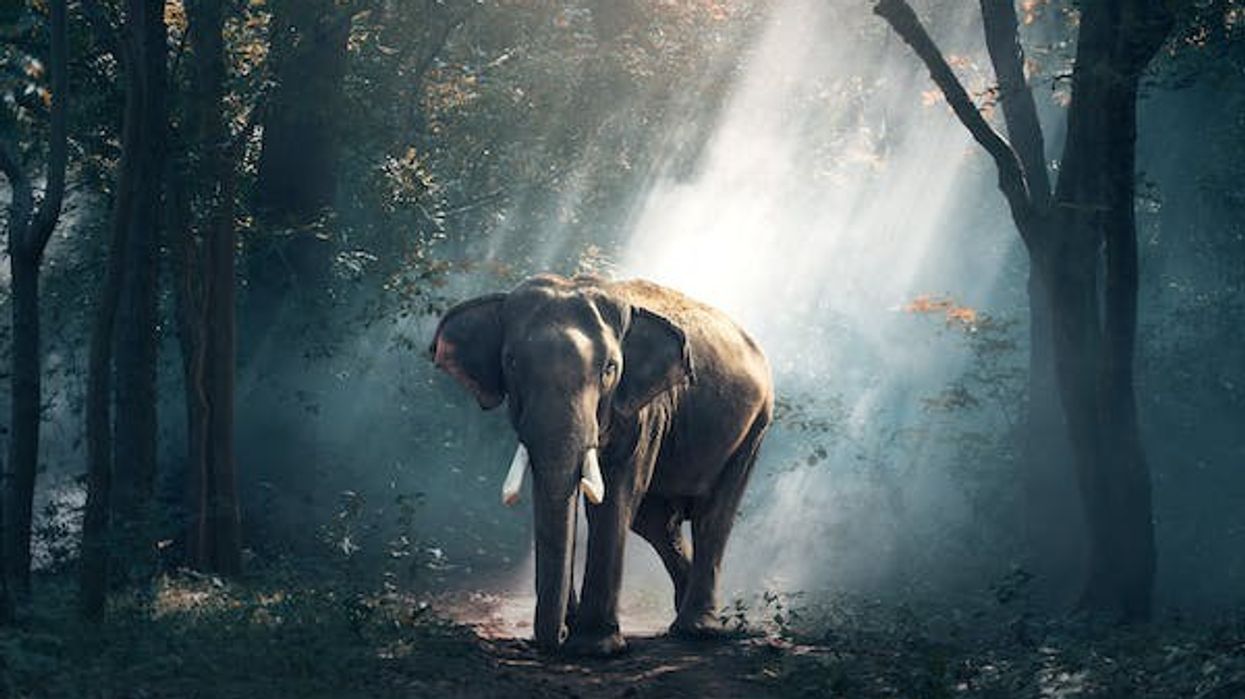The Bison bonasus species, also known as the European bison or wisent are primarily found in several parts of Europe. After the second world war, the population of the species divided by international borders.
The European bison is found in countries such as Poland, Latvia, Switzerland, Kyrgyzstan, Germany, Lithuania, Belarus, Ukraine, Slovakia, and Russia. The species primarily dwell either in deciduous forests or the lowland forest.
These huge sized bisons resemble the North American bison but this species possess a less shaggy coat and are found in golden brown or dark brown variants. The hair on the neck and head is shorter while their tails and horns are quite long.
The average length and height of the species are 114 in (2.9 m) and 70-74 in (1.8-1.9 m) respectively, while they weigh around 1763-2204 lb (800-1000 kg), the heaviest wildland animal of Europe. Also, the newly born calves weigh around 33-77 lb (15-35 kg).
Since the 15th century, a population was protected in the Białowieża forest, Poland. After the establishment of the Bison Restitution Centre at Białowieża forest in the third decade of the 20th century, the species was again introduced to the wild.
The International Union for Conservation of Nature has listed the species in the Near Threatened category as the population is increasing steadily.
Keep on reading to learn more interesting facts about the European Bison. If you want to know more exciting information about different animals, check out these Chinese water deer facts and key deer facts.
European Bison Interesting Facts
What type of animal is a European bison?
The European bison (Bison bonasus) is a herbivore mammal that primarily preys on leaves, stems, flowers, wood, and bark. The bisons found in the Bialowieza forest are the ancestors of the living European bison.
What class of animal does a European bison belong to?
The European bison belongs to the class of mammals, the family of Bovidae, and the Bison genus.
How many European bison are there in the world?
A survey of 2019 states that there are around 7,500 European bison found in different parts of Europe, half of the population is found in Poland and Belarus. Also, there are only 11 and 10 bisons left in Hungary and Austria respectively which is a matter of concern.
A small population of the species was reintroduced in the Altai Mountains of East Asia in 1983.
Where does a European bison live?
European Bison are found in countries such as Poland, Latvia, Switzerland, Kyrgyzstan, Hungary, Austria, Germany, Lithuania, Belarus, Ukraine, Slovakia, and Russia. After the second world war, the population of the bison was divided by international borders.
What is a European bison's habitat?
European bison primarily dwell in mixed or broad leaved forests. Grasslands, mown meadows, and young plantations of around 10,000 years old serve as a habitat. In short, the European bison inhabit the deciduous and lowland forests.
Who do European bisons live with?
Like other mammals, the European bison prefers to live in groups while the male bison or bulls spend most of their life alone. The bison herds generally consist of around 20-23 individuals while the herd of bulls comprises two to three individuals.
How long does a European bison live?
The wild bison generally live for around 14-24 years while those living in captivity can easily live up to 28 years. It is also said that the free ranging herds can not live for longer than 16 years.
How do they reproduce?
Before breeding, the pre-rutting period occurs in which the bulls try to approach and isolate the female bison or cow. The European bison follow the polygyny mating system that means the bulls mate with more than one cow in a season.
Males are involved in fights if another bull tries to approach the cow during this period. Bulls reach sexual maturity after two years of age while females attain after three years of age.
The breeding season generally occurs between July and October and the bison only mate once a year. The gestation period primarily lasts for around 250-270 days and cows give birth to only one offspring or calf.
After birth, only female parental care is involved and the weaving period lasts for more than 10 months. Studies also reveal that the cow can give birth until 18-20 years of age.
What is their conservation status?
Since the 15th century, the population of the European bison (Bison bonasus) is declining and several steps have been taken for European bison conservation. The Bison Restitution Centre was formed in 1929 at Białowieża, Poland.
Also, within the Prioksko-Terrasny Biosphere Reserve, the Bison Breeding Centre was established in 1948. In the last decade of the 20th century, the International Union for Conservation of Nature declared the bison as Endangered species which is now changed to Near Threatened.
The major threats to these mammals are poaching loss of habitat and diseases. In the last two decades, one can observe a significant growth in the population due to several captive breeding programs.
European Bison Fun Facts
What do European bisons look like?
European bison have golden brown or dark brown coats, these animals possess hair on their neck as well. The newly born calf weighs around 33-77 lb (15-35 kg).
The female bison stays with the calves for more than 10 months until they are matured enough, the same can be seen in the picture. This newly born calf would forage near its mother.
How cute are they?
These huge-sized animals look really cute and adorable when they are grazing. The cute little calves stick close to their mothers all the time. The baby bison is also very curious and loves to play with other family members all the time. Their small faces resemble fluffballs.
How do they communicate?
Like other animals, the European bison follow the same methods of communication. These animals generally use their body movements, smell, and sounds.
The bulls are quite territorial and usually, grunt, growl, and snort to show their dominance. They are also involved in the fight if some other male tries to approach the cow. Also, the calves generally squeal after getting separated from their mother.
How big is a European bison?
The average length and height of these animals are 114 in (2.9 m) and 70-74 in (1.8-1.9 m) respectively, while they weigh around 1763-2204 lb (800-1000 kg), the heaviest wild animal of Europe. The wisent bison is also a bit bigger than the American bison.
The European bison is twice the weight of the paint Horse and four times bigger than the Bengal Tiger.
How fast can a European bison run?
The average speed of the European bison is around 35 mph (56 kph). The strong legs of these animals help to cover long distances and avoid predation. Also, the bison runs faster than the giant white rhinoceros.
How much does a European bison weigh?
The adult European bison weigh around 1763-2204 lb (800-1000 kg) while the newly born baby bison weighs around 33-77 lb (15-35 kg).
What are the male and female names of the species?
Male European bison are called bulls while people usually refer to the females as cows.
What would you call a baby European nison?
The babies of bison are generally called calves.
What do they eat?
European bison are herbivores and primarily prey on leaves, stems, flowers, wood, and bark. Also, the cows generally suckle their babies.
Are they dangerous?
As these giant sized animals are losing their natural habitats, the species is becoming more aggressive and dangerous. Along with domestic animals, European bison are quite dangerous for humans as well.
In search of space and food, the bison attack farms, human settlements and cause crop destruction on a large scale. The bison possess horns and usually attack if someone tries to come closer or provoke these animals. Also, the massive American bison found in several states of North America usually attack locals.
Would they make a good pet?
Unlike other domesticated animals such as horses, bison are not regarded as pets. These free living animals generally belong to the wild and would not survive in small sized farms, the farm size should be more than five acres for a pair of adult bison. Sometimes, the tamed bison can also attack if they feel frightened.
Did you know...
During the middle ages or medieval period of Europe, the bison became extinct and were only seen in the Caucasus mountains of Europe and Asia.
In 1952, a pair of bison were released in the Białowieża Forest of Poland and after a decade, the population increased to 100.
In Europe, the European bison is the national animal of several countries such as Belarus and Poland.
Till the late 19th century, the wild bison provided raw materials and food to the native people of North America. The European settlement is a major reason for the population decline in America.
The term 'zubr' is also used by the native people to call the European bison.
The temperament of the European bison
The nature of the species is quite unpredictable. These peace loving animals could attack at any moment without any reason or warning.
The bison generally weighs more than 2000 lb (900 kg) and possess longer horns that can be very dangerous for animals and humans. The bulls are territorial and become quite aggressive during the rutting or breeding season.
They have strong legs and move at a speed of more than 35 mph (56 kph) and usually attack if someone tries to enter their territory. It is always advised to stay away from these belligerent, dangerous animals.
What is the difference between American bison and European bison?
On several physical and behavioral factors, one can differentiate the American and wild European bison. The American bison has 15 pairs of ribs while the bison of Europe have 14 pairs. The European bison are taller and have stronger legs, unlike the American bison.
The European bison is less tameable compared to the American bison, the latter species runs faster with more stamina but the former jumps higher. The Wisent species generally graze more than the American bison.
Here at Kidadl, we have carefully created lots of interesting family-friendly animal facts for everyone to discover! For more relatable content, check out these spiral horned antelope facts and Artic wolf facts pages.
You can even occupy yourself at home by coloring in one of our free printable european bison coloring pages.









